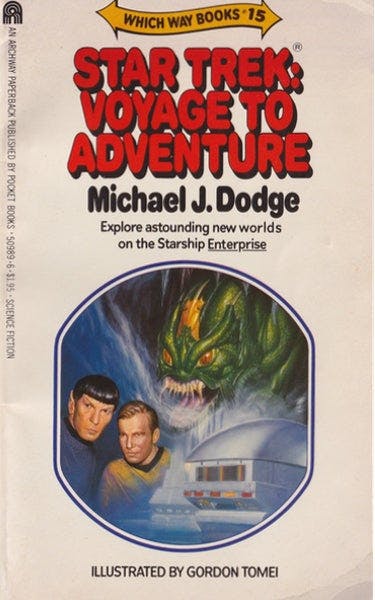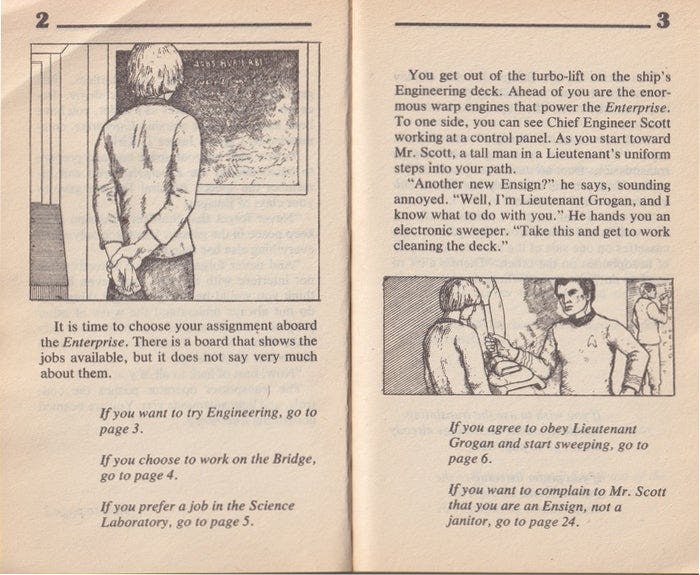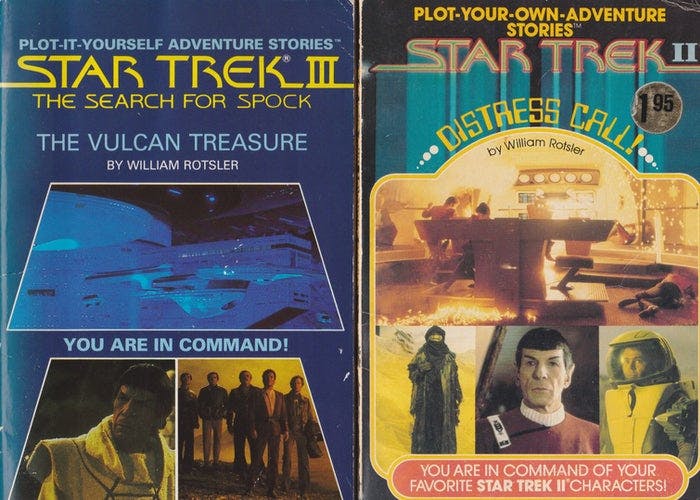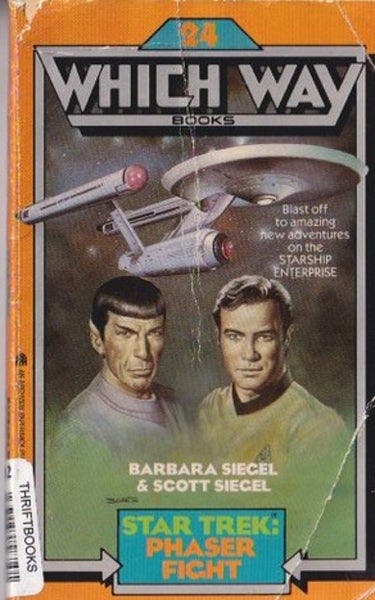Published Apr 23, 2020
Choose Your Own Voyage to Adventure
Exploring a Forgotten Chapter of Star Trek Children’s Media

StarTrek.com
As a child, my exposure to Star Trek was as a set of floating pieces: TV shows, movies, books, toys. I didn’t quite know how to parse out the original set of characters and those of The Next Generation, and when Star Trek: The Motion Picture (1979) played on TV, I watched it with my parents with almost no context for who those characters were. An eclectic set of books and comics came down to me from my older brother, and I read them not really appreciating their “secondary” status to the TV shows and movies; I remember some early novels including The Trellisane Confrontation and The Fate of the Phoenix, and even a quiz book. I did not really see the distinction between products for a general audience and those made specifically for children, but one of them quite clearly was meant for the younger demographic: Star Trek: Voyage to Adventure.

StarTrek.com
It was a work of interactive fiction, much like the familiar Choose Your Own Adventure books, though it was from a competing series called Which Way Books, published by Archway Paperbacks. Both series used second person storytelling where the reader gets to make choices that lead him or her to different outcomes – some positive, some negative. Pages would end with instructions like “If you fire a photon torpedo proceed to page 27. If you fire phasers, turn to page 56.” Published in 1984, Voyage to Adventure was credited to “Michael J. Dodge,” which, according to numerous sources, was a pseudonym for John M. Ford. Ford, the prolific science fiction writer who died in 2006, has started to receive a critical re-evaluation. His book The Final Reflection (1984) is considered one of the most important Star Trek novels for its intricate development of Klingon culture, in ways that filtered through to the series.
No such claims can be made of Voyage to Adventure, but it is a well-crafted item full of classic Trek feel. The protagonist, “you,” is a recent Academy graduate newly posted to the Enterprise, somewhat similar to the Short Treks entry “Q&A.” Your first decision is to decide between appointments to Engineering, the Science Labs, or the Bridge. As contrived as the concept may seem, the choices allow for a survey of stock TOS plotlines to follow: encountering a creature in engineering, routing out a Klingon spy, traveling through time, going to the Mirror Universe, a space battle with Klingons, making first contact with a volatile species, and more. There is a sense of humor in places – Ford was also the author of the madcap How Much for Just the Planet? (1987), one of the most overt comedies in the Star Trek novel canon – especially in a plotline where a self-aware breakfast computer floods the Enterprise with oatmeal.
The “you” is not clearly gendered in the text, but is visualized in Gordon Tomei’s illustrations (always drawn from behind) looking a bit like Chekov with a shaggy Beatles cut (one might wonder if “you” literally are meant to be Chekov, except he does appear in the book). One of the most interesting plotlines is the time travel one, where the protagonist interrupts an experiment Spock is doing in the science lab and ends up forty years in the past! The captain is a fun easter egg, the rarely mentioned Robert April, introduced in The Animated Series’ “The Counter-Clock Incident.” The protagonist has read about him at the Academy and is now meeting a living legend. In more than one scenario, including the one that gets a memorable last page, “you” stay in April’s time and becomes part of the legend of the starship Enterprise, taking their place within the franchise’s storied history.

StarTrek.com
As early as the first edition of The World of Star Trek in 1973, David Gerrold lamented that ancillary Star Trek products like arcade games were about simplistic violence with clear heroes and villains. Voyage to Adventure, while scarcely intellectually complicated, is at least in keeping with Star Trek values: the violent or impulsive decision is almost uniformly the “wrong” one, which often leads the player to die a hideous death (one is tempted to say, a redshirt’s death). There is one point where deciding to fire at a hideous monster results in aliens deciding that you are too violent to open relations with, resulting in your being mindwiped.

StarTrek.com
This is not the only piece of Star Trek interactive literature. William Rotsler authored two YA-oriented books tied in with film series — Distress Call! (1982) and The Vulcan Treasure (1984), published by Wanderer Books. These are different, as there are no pretenses that the reader is a character within the story’s action, but rather can choose the way the plot unfolds in a more omniscient fashion. Which Way Books followed up on Voyage to Adventure with Phaser Fight (1986), written by Barbara Siegel and Scott Siegel.
As the title implies, it’s more oriented towards action and sensation. While it similarly begins with the reader arriving on the Enterprise and having to choose a department, this time Kirk, Spock and McCoy all turn up to actively compete over you. It’s hard to picture Spock saying lines like “We’re going to throw Federation Medal at him! You’re looking at the hero who saved the Enterprise!” There are execrable puns: at one point you are beamed into solid rock leaving only the top of your head: “Hair today, gone tomorrow!” At another point, you are praised for an “enterprising victory.” The strangest thread culminates when the debris of the Enterprise are described as containing a copy of “a strange little book called PHASER FIGHT!”

StarTrek.com
There is a tendency to treat the more “juvenile” incarnations of Star Trek as ephemera at best and embarrassments at worst. But perhaps that is beginning to change, signaled by how the historical neglect of the Star Trek animated series has been reversed in recent years. In 2019, the announcement of a new animated series by Nickelodeon was framed in terms of, “excitement at bringing Trek to a younger generation around the world.” Hopefully, it trends more towards the material in Voyage to Adventure, which brims with Trek flavor without speaking down to the younger Trek fans, who certainly deserve our respect.
Murray Leeder (he/him) holds a Ph.D. from Carleton University and is a Research Affiliate at the University of Manitoba. His research interests include the supernatural in media, horror film, Bob Dylan and, unsurprisingly, Star Trek.

